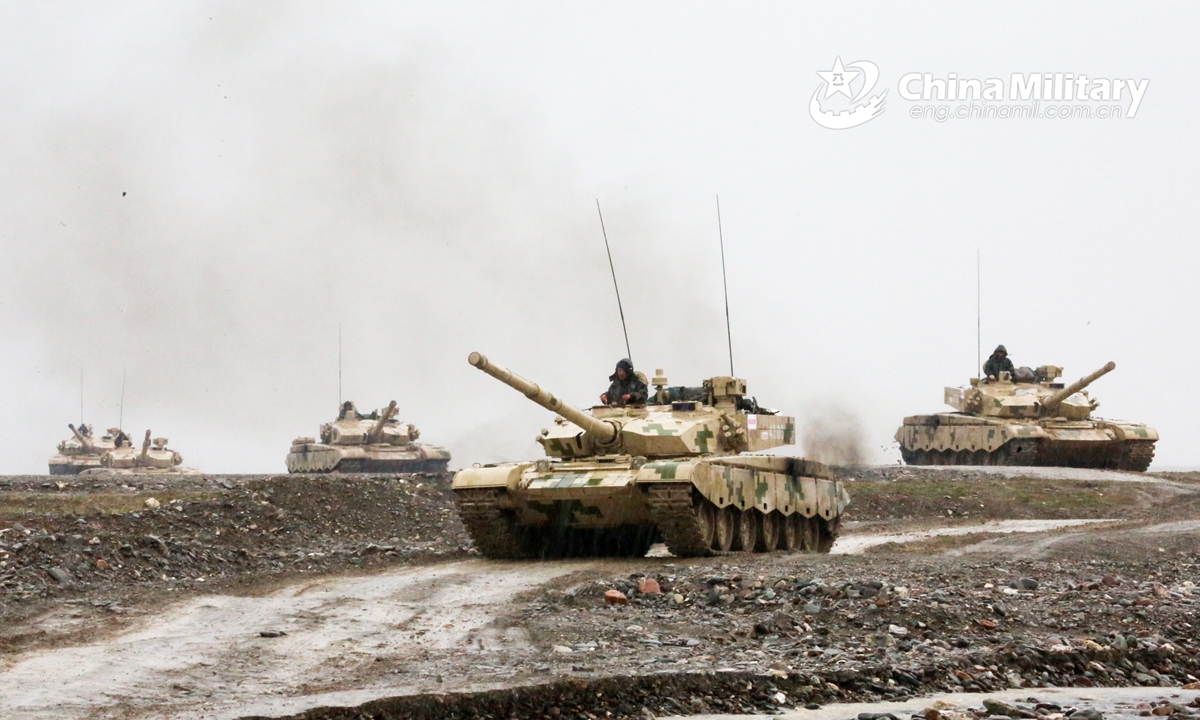China’s armed forces have deployed their most powerful Type 99A Main Battle Tank (MBT) in the high altitude border frontier at Karakoram Mountains. A report published by Global Times. The deployment comes with the supplies to celebrate the spring festival arriving in the hands of PLA border troops.
The People Liberation Army Xinjiang Military Command dispatched a transport regiment to let the already deployed troops enjoy the warm Spring Festival. China Central Television (CCTV) reported.
The high-altitude border frontier at Karakoram Mountain range lies at more than 5000 meters above sea level. Beijing has deployed Type 99A MBT and Type 04A Infantry Fighting Vehicles at the high-altitude mountain range.
Chinese Army Xinjiang Military Command recently commissioned the first batch of China’s newly developed Type 15 light tank. According to Chinese military analysts, it would complement the heavy Type 99A Main Battle Tank and become a good partner in combat.
Russia’s next-generation ‘Centurion’ combat suit of the future
What is India up to?
India has deployed Russian-T90 MBT against the People Liberation Army (PLA) in the disputed region of Ladakh.
At the height of 16000 feet above sea level just south of Karakoram pass, there lies the last outpost of the Indian military at Daulat Beg Oldi DBO.
“With the Chinese People’s Liberation Army (PLA) deploying close to 50,000 troops in Aksai Chin, the Indian Army for the 1st time has deployed a squadron (12) T-90 missile-firing tanks, Armoured Personnel Carriers (APCs) and a full troop brigade (4000 men) at Daulat Beg Oldi (DBO) to prevent any Chinese aggression from the Shaksgam-Karakoram pass exis, according to top military commanders familiar with the matter.” Hindustan Times said in a report.
There exists a disputed territory issue between India and China over Ladakh.
What is the Ladakh standoff?
Ladakh is a region administered by India as a union territory. It is a part of the larger Kashmir region, which has been the disputed area between China, India, and Pakistan since 1947. Due to the Ladakh issue between India and China, the disputed border region has been a hot boundary between two nuclear power countries since last year.
The 21st century is going to be the Chinese century
“Part of Pangong Lake in Ladakh, is one of the sites of ongoing India-China standoff”, According to The Diplomat. “January 15, 2020, will go down in history as a day on which two nuclear powers China and India were on the brink of a fight over their disputed border.”
Indian T-90 tank in Ladakh:
India has deployed its Russian T-90 tanks in Ladakh. T-90 is a Russian made third-generation battle tank. It is a 45-ton Main Battle Tank lighter than the US M1A2 Abrams 70-ton tank.
T-90 MBT includes a 125 mm cannon that can fire shells as well as anti-tank guided missiles. Its defense systems include Kontakt-5 explosive armor and the Shtora infrared jamming system to block incoming anti-tank rockets. India has customized its variant, T-90S Bhishma with a French-made thermal imaging system.
Iran rejects new talks or participants in nuclear deal
Chinese Type 99A MBT and Type 15 light tank:
The Type 99 MBT was China’s first mass-produced third-generation Main Battle Tank.
The Type 99A with 55-ton weight is China’s most powerful main battle tank which includes combining modular composite armor and tandem-charge defeating explosive reactive armor (ERA). It has a 125 mm smoothbore gun with Anti-Tank Guided Missile (ATGM) capability, and digital systems and optics.
The Type 15 light tank is newly commissioned, excels at rapid reaction combat in plateau regions, a Chinese expert said. It has a weight of around 33-tonnes. Type 15 has a 105 mm rifled gun.
“The Type 15 tank is easy and flexible to operate and has high mobility, as it is equipped with a new engine designed for plateau missions and an oxygen producer. It also uses new armor materials and stealth technologies, so it has reduced weight but better protection and stealth functions”, Zhang Hongjun, a master sergeant class one at the regiment, said in a CCTV report. According to Global Times.
US military working on adding muscle to robots
Type 15 tank strikes a balance between firepower, mobility, and protection to best suit plateau regions, where harsh environments hinder weapon performance compared with operating in planes, Song Zhongping (Chinese military expert and TV commentator) told Global Times.
Comparison of tanks:
The Type 15 light tank is a newly commissioned battle machine. According to Chinese military experts, it is highly adaptive to mountainous terrains, which makes it a very lethal war machine. On the other hand, the Indian T-90 MBT is relatively heavier and it may be difficult to operate on poor roads. But as compared to Type 15, T-90 has superior firepower and armor protection.
The T-90 tank was used in battles many times. As it is an advanced version of the Soviet Era’s T-72 tanks. Russian T-90 also fought in Syria, with at least one being badly damaged by a US-made TOW anti-tank missile fired by Syrian rebels. While Chinese Type 15 s have yet to see combat.
$6 trillion and 8 hundred thousand of lives, the cost of US global war on terror
“They are not there to defend Indian territory but to threaten Chinese territory”, Arzan Taraporey, a non-resident fellow at the US-based National Bureau of Asian Research think tank said. “This is and has long been Indian doctrine: to threaten a punishing riposte against China – ideally to strengthen India’s hand in disengagement negotiations; or in the worst case, to actually try to seize Chinese territory as a bargaining chip to reverse China’s incursions.” Actually, this is a counteroffensive act.
Analysis:
Chinese military experts said that Type 15 light tanks will complement Type 99 MBT which enhances the battlefield efficiency and mission competency during the war.
The deployment of Type 99 Main Battle Tank and Type 15 light tank by China and T-90 tanks by India on the disputed Ladakh border put both the nuclear-armed neighbors one step closer to war.
The deployment of war machines in Ladakh also helps both countries to avoid offensive operations.
Sources:
- Article published in the Forbes
- Article published in the Global Times
- Article published in Hindustan Times


